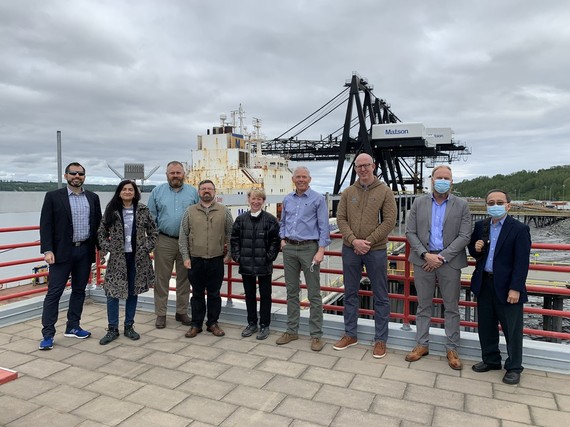AEO, Denali Commission partner to support rural Alaskan utilities
The Arctic Energy Office (AEO) has implemented a partnership with the Denali Commission (DC) in Alaska to collaboratively tackle challenges facing many rural utilities in Alaska. An interagency agreement now allows the two organizations to streamline staffing and funding, starting with the SUPER—Standalone Utility Personnel Engagement Resource—project.
AEO and DC will work with utility and community leadership representatives to characterize training and support requirements for standalone utilities across the state. They will also draw from resources within the state and across the DOE offices to address these needs. Learn about the job opportunity to help advance this effort.
This collaboration will lead to a training manual to highlight best practices, deployed via a field training program and online; onsite training sessions; and ongoing program maintenance, including best practices outlined in training manuals. The two partners will also oversee a field training program. The partners plan to leverage opportunities at various conference events to promote this training to other entities with similar missions.
 Office of Technology Transitions and Arctic Energy Office staff surround Dr. Geraldine Richmond, center, and Port of Alaska staff at the Port in Anchorage in May. Courtesy of Michael McEleney
New Port of Alaska-Sandia Lab MOU aims to increase energy reliability
Could integrating renewable energy and upgrading the power grid at the Port of Alaska in Anchorage improve fuel and freight deliveries throughout the state? A new Memorandum of Understanding aims to increase grid reliability and resilience at the Port and to incorporate this vital transportation hub into a clean energy economy.
At the Port of Alaska on the Upper Cook Inlet, staff manage half of the state’s inbound freight—including fuel and food. When the port experiences power outages, those outages lead to increased costs and shipping delays and to cascading transportation impacts down the line. The port, managed by the Municipality of Anchorage, is interested in supplementing its generation resources with renewables and modernizing its grid to improve operational efficiency and resiliency, as well as supporting business development.
Sandia researchers will provide expertise in renewable energy technologies, microgrids, lifecycle assessment, and market analysis to evaluate different scenarios for clean energy integration. This work builds on the knowledge and experiences Sandia has gained from over 25 years of research and development in the Arctic. Read more.
Four remote villages use DOE funds to evaluate local energy opportunities
Four Alaskan communities—Igiugig, McGrath, Nikolski and St. George--will receive DOE funding to explore ways to add sustainable energy generation to their portfolio and train the local workforce to maintain it. These geographically isolated communities have high energy costs and are vulnerable to an increased risk of natural disasters and climate change.
They were among 12 communities competitively selected for the second phase of the Energy Transitions Initiative Partnership Project (ETIPP), which pairs national labs and local community partner organizations with U.S. communities to increase energy reliability, sustainability, and affordability. (In Alaska, those partner organizations are the teams at the Renewable Energy Alaska Project and the Alaska Center for Energy and Power.) Learn more and watch this video to hear from Alaskan partners involved in the ETIPP program.
Briefs
Job opportunities
We are seeking a permanent Arctic Energy Office Director. Apply here by Aug. 31. For other jobs related to our mission, check out AE’s page or DOE’s Clean Energy Corps.
The Renewable Energy Alaska Project seeks an Electric Utility Training Coordinator to implement the SUPER project. Apply by July 22.
Cold Climate Heat Pump Technology Challenge
DOE launched its Residential Cold Climate Heat Pump Technology Challenge to improve heating efficiency in freezing temperatures without emitting greenhouse gasses. The goal is to save families up to $500/year on utility bills while achieving President Biden’s goal of a net-zero carbon economy by 2050. DOE is partnering with the U.S. Environmental Protection Agency and Natural Resources Canada to produce these heat pumps in the United States. Researchers at NREL’s Cold Climate Housing Research Center and the Alaska Center for Energy and Power are actively engaged in field work involving heat pumps across the state, which could well provide valuable input for the Challenge.
ARENA brings Arctic nation representatives together
The Arctic Remote Energy Network Academy (ARENA), a pan-arctic capacity building and peer networking program funded in part by AEO, will hold an on-site program in Alaska from July 17-23. The group begins in Fairbanks then travels to Kotzebue and the Northwest Arctic Borough. This fall and winter, they will also visit Iceland and Canada. Learn about the program and participants here.
Alaskans participate in NREL’s Energy Executives program
Congratulations to Jolene Lyon of the Bering Straits Regional Housing Authority; Mindy O’Neall of NREL’s Cold Climate Housing Research Center; and Curtis Thayer of the Alaska Energy Authority, for being selected for NREL’s 2022 Energy Executives Program. Learn more.
Please stay in touch…
We welcome your feedback! Email us at ArcticEnergy@hq.doe.gov and follow us on Twitter at @ArcticEnergyDOE!
|